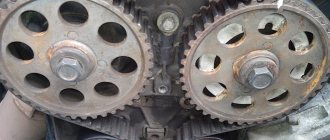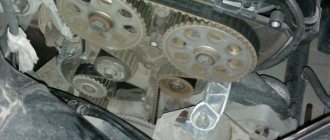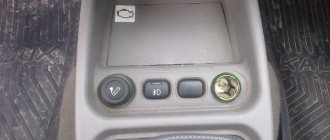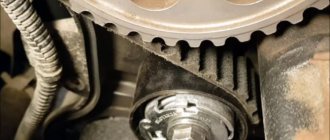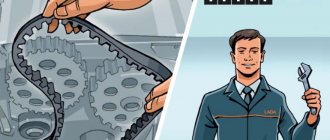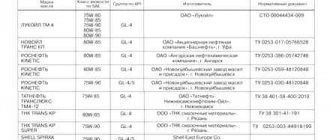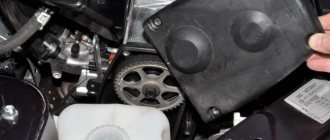It is recommended to check the timing belt every 15 - 20 thousand kilometers. A broken belt on an 8-valve Kalina is not fatal; the valves will remain intact, but on a 16-valve Kalina it will bend them. Therefore, you need to monitor the timing belt and promptly change it to a new one (its service life is from 50 to 80,000 kilometers). The process of replacing the timing belt is almost the same for both 8 and 16 valve engines.
First you need to remove the plastic timing belt protection, which is secured with 3 bolts.
Now you need to remove the right front wheel. You will have access to the right engine protection panel. Unscrew the 2 screws that secure it and pull it down. Now we can reach the pulley on the crankshaft.
Before this, you need to rotate the crankshaft and install both sprockets (crankshaft and camshaft) according to the marks:
To unscrew the flywheel you need to lock the crankshaft. On the clutch side, the engine has a special viewing window through which the flywheel is visible. We remove the rubber band and lock it with a powerful screwdriver. For this you will need an assistant.
The pulley can be very tight, so don't be surprised if it won't come off.
Then you need to remove the alternator belt.
We remove the pulley, remove the old belt. To do this, unscrew the tension roller and release the belt as much as possible. Now ATTENTION! Make sure that the gears do not go astray.
We begin to put the new belt on the crankshaft gear. Then we pull it onto the camshaft gear on the right side. We keep an eye on the signs all the time. Next, we pass the belt through the roller and pull it onto the pump.
We tighten the timing belt using a roller. For this I used a homemade key made of steel wire (2-3 mm):
The belt must be tensioned so that it can be rotated 90 degrees, but no more, no less. After tensioning, turn the crankshaft 2-3 turns and again look to see if the marks are off. If it goes wrong, then we remove it and set everything again.
We reassemble in reverse order.
Engines can be equipped with a timing gear drive with an automatic timing belt tensioner or with a tension roller.
In the latter case, it is necessary to regularly (when performing maintenance, every 15,000 km) check the condition and tension of the timing belt, and change it every 75,000 km.
With an automatic tensioner, there is no need to check and adjust the timing belt tension. In addition, in such a drive the service life of the belt itself is significantly increased. This does not exclude failure of the tension mechanism or oil leakage through the shaft seals.
Oil getting on the timing belt leads to a significant reduction in its service life.
Breaking teeth on the belt will result in poor valve timing and possibly serious engine damage.
A broken belt will inevitably cause the engine to stop. Taking all this into account, on engines with an automatic tensioning mechanism, it is advisable to check the condition of the timing belt, and if defects are found on it, replace it.
After how long to change the timing belt on Kalina
Problem Lada Kalina b
Choosing a used Kalina Lada requires the ability to carefully assess the technical condition of the car. Starting from the replacement of consumables to the performance characteristics and shortcomings of the engine, gearbox and other main components of the machine.
More on the topic of used budget cars :
Technical specifications, engine and gearbox characteristics
Four-cylinder gasoline engines are installed on VAZ 1117, VAZ 1118, VAZ 1119 engines :
All engines are mated to a 5-speed manual transmission. Engine life: if you are lucky, you can drive more than 250,000 km, but the engine may surprise you at 30-40 thousand.
Oil change every 15 thousand, timing belt according to regulations they change every 60 thousand (we recommend every 50 thousand mileage). There are no characteristic diseases; any component can malfunction in the engine, from movement of liners to cracks in the cylinder head.
Similar to a transmission, only its lifespan is much shorter, and malfunctions are more common. The gearbox generally does not last up to 100,000 km; the original clutch disc often requires replacement for 25-30 thousand. Although imported spare parts are more expensive than original VAZ units, they take care of much more.
When choosing a used Lada Kalina, it would be superfluous to check and verify the uniformity of compression in all engine cylinders. Don't be afraid of extraneous sounds from the gearbox. box howl. feature of the Kalin family.
Steering rack The power booster can bring unexpected surprises in the event of a breakdown (steering load increases sharply). a problem inherent in Lada Kalina, produced before mid-2006. In younger cars, the power steering problem was eliminated.
Resource life of the timing belt and generator, pump, as well as viburnum tension rollers
How much
serve as a factory for
timing belts
, alternator, as well as tension rollers for both timing belt and alternator. My personal.
Timing belt. A resource for when you need to change. Just something complicated
Have you ever thought about the impact on a resource? timing belt
? Why can he drive 120.150,000 kilometers in foreign cars?
The front suspension of the Kalina is independent with MacPherson strut supports and an anti-roll bar, the rear is semi-automatic with a beam and a stabilizer. It works energy-intensively, comfortably according to VAZ standards. Handling is better than that of the VAZ 2110, but not far from the average foreign car. Cars with high heel cornering, a wide range of vertical body shells, aerodynamic noise and poor interior insulation are annoying at high speeds.
Problems with Lada Kalina in the technical part
The weakest points of the suspension. These are stable stabilizers and shock absorbers. Replacing shock absorbers with imported ones changes the steering nature of the Lada Kalina for the better. Ball bearings, silent blocks, like many other components and assemblies of domestic viburnum, are similar to a tape measure. They can go a long way. 100-120 (you won't know where the part is installed) but you can interrupt it as often as once a month. In general, everything has been repaired, and the price of spare parts will not undermine the family budget.
To summarize, we summarize this with the choice of Lada Kalina Second-hand should be careful and preferably “manual”, because it is better to repair it yourself. AvtoVAZ's terrible service will not change for the better.
Cost of used and new cars
On the secondary market, viburnum can be purchased at a price of 120–130 thousand rubles.
The initial configuration of Lada Kalina was equipped with a 1.6-liter 8-cell engine. (81 hp) with 5 manual gearboxes, the “chips” will be represented by an alarm system, an on-board computer, height-adjustable, power steering, and front power windows.
The price of the new Kalina hatchback starts at 293,900 rubles for a car in the initial configuration with a 1.6-liter engine (81 hp) and rises to 401,000 rubles for a set with a 1.6-liter engine. For such a small amount for a Russian car, Kalina will be equipped with front driver and passenger airbags, fog lights, alarm and central locking system with remote control, heating, power mirrors, power windows for all side windows, air conditioning, rain sensor, ABC sensor rain, ABC drive, on-board computer, power amplifier, CDMP3 audio system, navigator. For the Lada Kalina station wagon in its original configuration, the standard costs from 298,900 rubles, for the Luxury it will cost 408,300 rubles.
In Ukraine, the cost of the VAZ Lada Kalina 1119 (hatchback) varies from 70,290 UAH for the initial configuration to 81,390 UAH for a rich filling. The VAZ LADA station wagon costs from 74,070 UAH to 85,170 UAH.
What is a timing belt
Of course, the vast majority of motorists are aware that there is a timing belt in the car, what it is needed for and what the abbreviation means. If you are not already aware of this issue, this omission needs to be corrected immediately, filling the gap in the knowledge base of any driver. Knowing what a timing belt is in a car and when to replace it is the responsibility of every vehicle owner.
The timing belt is a gas distribution mechanism, which is an internal combustion engine device, whose purpose is to control the supply of the air-fuel mixture, and the dosing procedure is performed at certain time intervals.
The belt, made of high-quality reinforced rubber, is part of the gas distribution structure. It has an important role in ensuring synchronous operation of the crankshaft and camshaft. Thus, the timing belt determines the movement of the mechanism components and is a direct participant in the procedure for supplying fuel and exiting combustion products.
The coordinated functioning of the mechanism parts also determines the optimal operation of the vehicle’s power unit. The condition of the device affects the serviceability of the entire mechanism, and its replacement is strictly regulated by the automaker; a description is included in the vehicle’s operating instructions.
If during the period of car warranty service you don’t have to worry about the quality of the timing belt, especially since the manufacturer supplies the original part, then in the future, when purchasing a replacement part, you need to be especially careful and not try to save money by purchasing a low-quality product, because the functioning of the engine depends on it.
There are symbols on the timing belt, let's look at examples of translation of the decoding:
- 136-25.4 HNBR, where 136 is the number of teeth, 25.4 is the width of the belt, and HNBR is the material from which the part is made. This model is made of heat-resistant rubber that is resistant to ozone and chemicals, and also contains varying levels of acrylonitrile;
- ISO-58111x The first numbers (58) indicate the series of teeth, the next three indicate their number (111), the last value (19) indicates the width of the product in millimeters;
- 58127x3/4 HSN. The first digits are also the series number, the subsequent ones indicate the number of teeth, 3/4 is the width in inches (19 mm). The HSN marking stands for highly saturated nitrile, a modern belt material that is particularly durable.
Replacing the timing belt must be approached with all responsibility, since by ignoring the need for the procedure, you can bring a number of problems to your car and the quality of the purchase must be taken care of first of all. It is very important that the belt is original, so special attention should be paid to the manufacturer.
On some Japanese car models, the timing system is driven by a chain. If so, then there is no need to worry that the replacement date may be missed; the chain is replaced after 200,000-250,000 km. Well, the usual timing belt is most often replaced at each scheduled maintenance.
Auto-assistance
The Lada Kalina passenger car, the first generation, was produced for a little over 8 years (2004-2013). It was equipped with both 8-valve engines (VAZ-21114) with a displacement of 1.6 liters, and 16-valve engines (VAZ-11194 and VAZ-21126) with a displacement of 1.4 and 1.6 liters. And since mid-May 2013, the second generation of these cars has been produced.
When the timing belt breaks on eight valve engines, there is no meeting of the valves with the pistons of the crank mechanism, but on the 16-valve Lada Kalina engines of the first generation, with such a malfunction, the valves bend, and sometimes even, on top of everything , breaks the piston or bends its skirt. Therefore, when the question arises about replacing the timing belt, owners of Kalina, with 16-valve engines, must be guided by the maintenance instructions for this car, which states that the timing belt must be changed at TO-6 with a mileage of 75,000 kilometers.
But, you need to take into account that the service life of the timing belt is greatly influenced by the condition of the tension roller and water pump. If, when the engine is running, you hear extraneous noise associated with the appearance of play in the bearings of the above-mentioned devices, then the timing belt must be changed along with the tension roller and water pump, regardless of the number of kilometers traveled. In addition, you need to know that there are cases of selling defective timing belts. Therefore, after replacing them, you need to periodically inspect the timing belt for delamination of its edges or the appearance of cracks along the base of the belt teeth.
Those owners of Lada Kalina cars with 8-valve engines who know how to replace the timing belt do not have to worry about it breaking or cutting teeth if they have in the trunk a kit consisting of a tension roller and a timing belt, as well as the necessary tools, which will be needed to replace it. With skillful actions, this will require about an hour and a half of work in the warm season. Well, in winter, it’s still not advisable to operate the car until the timing belt breaks.
According to experience in operating Lada Kalina cars, the service life of tension rollers does not exceed 80,000 kilometers, and that of water pumps – 120,000 kilometers. Therefore, on a new Kalina, it would be more rational to replace the timing belt and tension pulley for the first time at a mileage of about 50-60 thousand kilometers, and to change the timing belt, tension roller and water pump again at a mileage of 110-120 thousand kilometers.
Share this article with your friends:
Consequences of a broken belt
A design feature of the 16-valve engines on the Lada Kalina is that the valves bend when the belt breaks. This defect is caused by the absence of grooves in the pistons, but the absence of grooves is not due to a mistake by AvtoVAZ engineers, it is necessary to increase the compression ratio in the combustion chamber. Therefore, a broken belt in a 16-valve engine foreshadows a major and expensive repair in 99% of cases.
Bent valves due to broken timing belt
To prevent the belt from breaking, it is recommended to monitor it every 20,000 km and check it.
This problem is not observed on 8-valve engines.
Checking the timing belt with automatic tensioner
1. We prepare the car for work.
2. Using a 5 mm hex key, unscrew the four bolts securing the front upper timing belt cover.
3. Remove the cover from the engine
4. Rotating the crankshaft (by the pulley bolt
or behind the flywheel ring gear, through the inspection hole in the clutch housing), we check the condition of the belt by external inspection. Make sure that the marks on the tensioner match.
The belt must be clean - without dirt or oil on its surface.
It is necessary to replace a belt with tears, cracks, delaminations, cut or worn teeth, abrasions to the cord, or oily ones. Oil leaks should be eliminated as soon as possible.
5. After inspection, install the cover.
see also
Comments 28
www.drive2.ru/l/8981345/?page=0#a163962325 On K-1 I replaced the belt, roller and pump, mileage 52,000, and because of the pump I changed it, it started to crunch and “pee”, although the belt and roller are still there something on the shelf.
I have already replaced the belt with the roller with 59000, I will change the pump later
At 45 thousand they did both valve adjustment and inspection (they had to according to the maintenance regulations). After the warranty expires, I don’t go to the officials, because... not satisfied with the quality of their work, price and attitude towards the client. That's actually why I'm asking :)
Don’t forget that the imported belt is ten times better quality than the previous one. generations of this engine. The self-tensioning pulley is also sold complete with a belt and is also considered a very high-quality product. But the pump... In stores they sell either Lada-detail or Luzar. On board. I saw someone in magazines praising the DOLZ L121. I think it’s somewhat naive to just change everything, new parts can be worse than the original ones. It is necessary to carry out troubleshooting by removing the belt, checking it carefully for cracks, peeling, the pump for jamming, play, squeaks and tension similarly. And then you can bring a candle to church))))
I don’t understand...WHY is this belt better than BRT? Everyone says high-quality, high-quality, high-quality. What is its quality?
It is clear that taste and color are all relative, but by default, imported spare parts from more or less famous manufacturers are considered to be of higher quality than domestic ones, if only because they have a longer service life compared to ours. There are exceptions, of course.
I used BRT on the previous 21103 (1.5-16 cells) (the salesman in the store said take it and don’t bother). So I changed it for 50,000 - it looked like new. And the second and third time I used only BRT. I drove the last one 70,000 and sold the car.
and on this gates supposedly 120 is stated, that’s the difference
I don’t know how much BRT claims.
I used BRT on the previous 21103 (1.5-16 cells) (the salesman in the store said take it and don’t bother). So I changed it for 50,000 - it looked like new. And the second and third time I used only BRT. I drove the last one 70,000 and sold the car.
GRT only for old ones for new ones 8 klp. he is not here
I don’t understand...WHY is this belt better than BRT? Everyone says high-quality, high-quality, high-quality. What is its quality?
There is no such thing even...
Don’t forget that the imported belt is ten times better quality than the previous one. generations of this engine. The self-tensioning pulley is also sold complete with a belt and is also considered a very high-quality product. But the pump... In stores they sell either Lada-detail or Luzar. On board. I saw someone in magazines praising the DOLZ L121. I think it’s somewhat naive to just change everything, new parts can be worse than the original ones. It is necessary to carry out troubleshooting by removing the belt, checking it carefully for cracks, peeling, the pump for jamming, play, squeaks and tension similarly. And then you can bring a candle to church))))
Whose link did you see?
There are cases of 20 and 50 and 60
on the nine it broke at 55t. km, on a 4-wheeler at 52t. km, but it didn’t matter there, valves and pistons do not meet.
Usually, potassium makers write that they change it closer to 60 t.km. And at about 50t.km maintenance they check the belt and rollers
The best timing belt for Lada Kalina
Choosing the best belt for Kalina is quite difficult, since when purchasing you can run into counterfeits of famous brands such as Gates and Dayco. It is these two brands that are most often counterfeited, since they are bought much more often than others. It is recommended to purchase products only from trusted stores.
From the factory, the standard belt on all Lada models is installed by Gates; AvtoVAZ gives its preference to it.
The table below shows timing belts for Lada Kalina with article numbers.
| Brand | vendor code |
| Gates | K015631XS |
| Gates | K015521XS |
| Dayco | KTB842 |
| Contitech | CT1137K1 |
Replacement
First, let's stock up on tools:
- keys to “10”, “13” and “17”;
- a large screwdriver with a slotted profile;
- wrench for installing the roller and adjusting the tension;
- jack;
- balloon wrench.
Before dismantling, you will need to set the timing belt to a special position (TDC). To do this, there are marks on the shaft pulleys, transmission housing and motor housing. So, replacing the timing belt step by step.
- Lada Kalina is located on a flat area.
- We jack up the right front side, and put wheel chocks on the rear wheels.
- Having opened the hood and armed with a size 10 wrench, unscrew the bolts (3 pcs.) holding the protective cover of the mechanism.
- The tension roller nut in LADA Kalina is unscrewed using a “13” wrench. The timing belt is loose.
- Now we dismantle the generator belt drive. To do this, we use a size 13 wrench to loosen the tensioning device.
- We look for the mark on the camshaft gear. It is presented in the form of a rectangular bead on the back surface of the edge of the gear itself.
- Rotating the shaft with a suitable wrench, align the indicated mark with the upper protrusion present on the mechanism housing fixation plate.
- We move to the box housing. It has a special window closed with a rubber plug. We pry it up with a long screwdriver and remove it.
- We see the flywheel of LADA Kalina. It has a mark that must be aligned with the triangular protrusion located on the left of the crankcase.
- If the phases are set correctly in advance (with the belt tensioned), then the two indicated pairs of marks must coincide. When this is not observed, we correct the position by rotating the shafts by the pulleys (you can spin the wheel by engaging 5th gear in advance).
- Next, we lock the flywheel using a screwdriver, pushing it through the crankcase window and resting it against the teeth.
- Now remove the generator set pulley.
- We remove the old LADA Kalina timing belt from the drive gears and roller.
- When installing a new belt drive, we check that the marks are not displaced. All manipulations are performed using the reverse algorithm.
- Tensioning is done by rotating the roller of the same name. We use a special key.
A correctly tensioned belt will allow you to use your fingers to rotate the idle branch (in the middle) 90 degrees. This will correspond to an applied load of 2 kgf.
- The roller fasteners can now be tightened to the required torque.
- We remove the screwdriver from the crankcase window and return the plug.
- After assembly, we check that the marks match (rotate the mechanism 2 full turns and look).
- We install the casing.
- Don't forget to put the wheel back in place.
During installation, it is important not to forget about the labels.
The timing belt replacement is complete.
Types of faults
In practice, there are three types of timing belt drive faults:
- loss of integrity;
- break;
- incorrect degree of tension.
The first option is dangerous due to belt delamination. Hanging threads will indicate this phenomenon. Sheared teeth are also quite common. Such damage is caused by incorrect adjustment of some components of the mechanism, including:
- gears on camshafts;
- crankshaft pulley;
- tension roller;
- cooling circuit pump;
The belt is tensioned using a special roller with an eccentric shaft. By rotating the roller, you can increase or decrease the tension level. The main thing here is to avoid excessive tension, which will adversely affect the condition and service life of the belt. Also, you should not leave a weakened belt drive, which threatens the teeth on the shaft gears jumping. In both cases, the timing belt in the Lada Kalina will stop functioning normally.
A belt break occurs if the owner of a Lada Kalina does not take timely measures to replace this important consumable component. When such a situation occurs, further operation of the 8-valve motor is impossible. The car should be transported by tow truck to the repair site. And the timing belt will need to be replaced.
Replacement procedure
The time for replacing worn parts in the timing belt is approaching, the driver thinks about the question of how to carry it out. Those who don’t want to get their hands dirty or have never had their car repaired prefer to turn to specialists. However, there are many owners who prefer to maintain or repair the car themselves. They are quite capable of this operation. You can do it in a garage or any suitable area. Work begins by opening the hood of the engine compartment, since most of the driver’s actions will take place in this place.
- First of all, remove the plastic cover covering the power unit. The windshield washer reservoir prevents the removal of the timing mechanism protection; it needs to be dismantled, especially since this does not cause any particular difficulty. Next, it is advisable to unscrew the spark plugs, having first removed the coils from them, this will make it easier to crank the engine in the future. The car is braked with a hand brake, stops are placed under the rear wheels, and the bolts of the right front wheel are removed. This side of the car is lifted with a jack, while not forgetting to place a stop under the car body, and the wheel is removed.
- When this is done, you can remove the upper protective cover of the timing mechanism, which is tightened with 5 screws.
- The next step is to remove the generator set drive belt. Release the tension mechanism and remove the belt. Now you can begin to dismantle the lower protective cover of the timing drive, which is held in place by only two screws.
- Some mechanics also disconnect the alternator belt tensioner rod for ease of operation.
- Now the timing mechanism needs to be aligned to the marks by turning the crankshaft pulley.
To get to it you will have to remove the fender liner, then the engine protection. Removing the pulley is not so easy; the crankshaft must remain stationary. This can be done by placing a flat-head screwdriver between the teeth of the flywheel ring and the clutch housing, or engage fifth gear and press the brake pedal. The pulley is removed along with the washer, and the bolt is put in place. Rotate the motor shaft until all marks coincide.
- There are two camshafts installed in the cylinder head, the gears of which should have their marks strictly opposite the marks of the rear protective housing.
- The gear on the crankshaft also has a boss; it is installed opposite the oil pump housing mark.
- It is also necessary to remove the rubber plug and make sure that the mark on the flywheel is located in the required place.
- After this, proceed to removing the timing belt.
First, its tension is weakened; to do this, the bolts on the tensioner and guide roller are loosened with a “15” head, the belt is removed from the pulleys and pulled out of the engine compartment.
- The tension roller is removed from the cylinder block, since it is usually replaced with a new product.
After this, it is strictly forbidden to turn the crankshaft or camshafts.
- Before reassembling, carefully inspect all parts of the timing drive mechanism. Before installing the rollers, it is advisable to coat the threads on the screws with a special lubricant; the tensioner screw does not need to be tightened too much yet.
- Once again, carefully check the alignment of the timing marks of the timing drive mechanism.
- Install a new belt on the pulleys, making sure that there is no sagging in the belt branch between the camshaft gears. If everything worked out, start tensioning the belt. To do this, the tensioner roller is turned counterclockwise until the movable mark on the outer race coincides with the stationary roller body, where there is also a mark.
- Now you can tighten the screw securing it. Further assembly occurs in the reverse order of removal.
